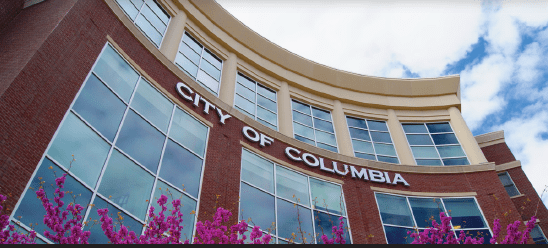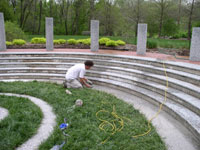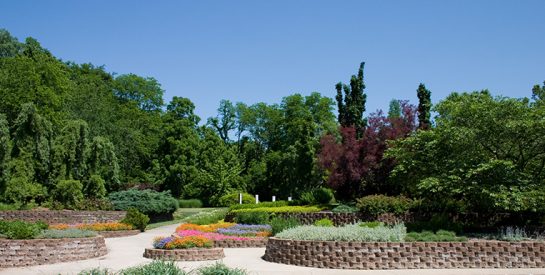
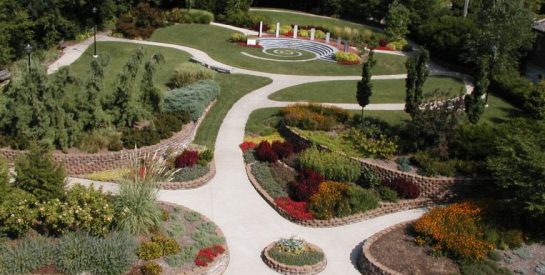
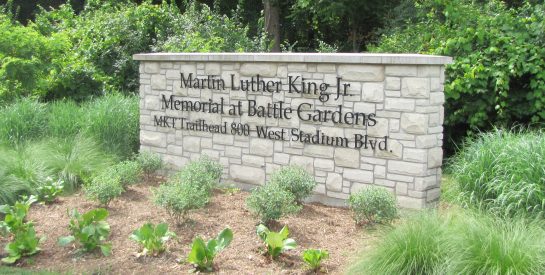
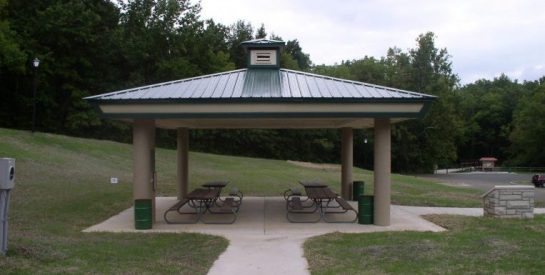
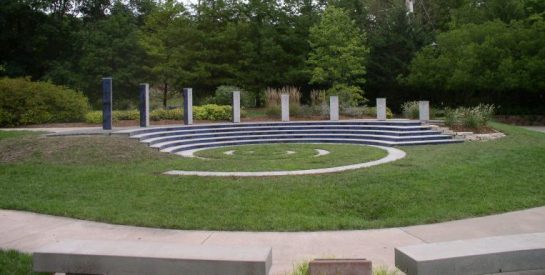
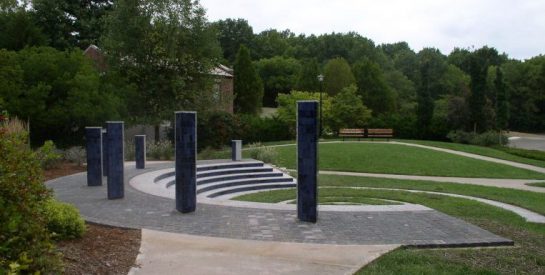
About Martin Luther King, Jr. Memorial at Battle Gardens
This beautiful garden is home to the Martin Luther King, Jr. Memorial – an art sculpture by Barbara Grygutis. The gardens can be reserved for outdoor weddings. There is a reservable picnic shelter, reservable MKT Trailside Building, and seasonal restrooms. The area also serves as a trailhead for the MKT Trail.
- Acres: 4.5 acres
- Park Hours: 6 a.m. to 11 p.m.
- Map of Martin Luther King Jr. Memorial at Battle Garden
Park amenities
Picnic areas
- Reservable Shelter
Restrooms (open April 15 to October 15)
Trails
- Trailhead for MKT Trail
- Exercise Stations
Park history
For many years, Columbia citizens dreamed of creating some type of memorial to honor the life of Dr. Martin Luther King, Jr. To begin to make the dream a reality, in February, 1988 the Columbia City Council appointed a committee including Liz Schmidt, Allen Tacker, Raymond Prince, James Gray, Tony Holland, Matthew Tyler and Janet Ruthenburg. During public hearings, citizens were asked to envision a memorial that would demonstrate a commitment to Dr. Martin Luther King’s dream of freedom, equality and justice for all Americans.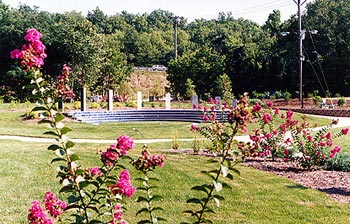
Liz Schmidt, George Farris, Beulah Ralph, and Tony Holland served as the four members of the second task force named by the Council in June, 1988. They were to develop a plan to appropriately honor Dr. King, as well as to recommend a site. This Task Force spent almost one year considering seven different sites and evaluating many different types of memorials, including naming a street or a new school for Dr. King. The Task Force’s final plan to the City Council advised that a special monument be located on a beautiful two-acre site in the heart of Columbia at the Stadium Boulevard entrance to the MKT Nature/Fitness Trail owned by the City. The Task Force felt that this central site would enable everyone in the community to come and learn more about the teachings of Dr. King.
The third and final committee, appointed by the City Council in November 1989 is responsible for determining the design of the memorial and raising the funds to erect it.
Martin Luther King, Jr. Memorial Committee (1989-1993):
James Gray, Chair * Walter Daniel * Liz Schmidt * George Farris Beulah Ralph * Joyce Jordan * Chris Janku * Sidney Larson Gertrude Marshall * Patrick Overton * Mildred Robertson
The committee held a national competition and twenty-five submitted models were evaluated by a five-member regional jury and a three-member national jury. The jurors’ selection was augmented by votes and comments from approximately five-hundred citizens who viewed the entries at the Columbia Art League.
The winning design was created by Barbara Grygutis, an artist from Tucson, Arizona. With the winning sculpture selected, the committee focused on fund raising. They established a public/private partnership to finance the project and created opportunities for community involvement. Over five hundred people gave generously to make this “Dream” a reality. School children and other organized groups enthusiastically sponsored fund raisers. The Committee’s fund raising goal of $52,775 for the memorial amphitheater went over the top. The City of Columbia appropriated $96,990 for the Garden and provided the site. Columbia’s Parks and Recreation Department completed engineering and construction of the garden while the Public Works Department engineered the sculpture footings, adding over $42,000 to the City’s contribution. The Artist, Barbara Grygutis, laid the final stones on the work. The landscaping was competed by the Columbia Parks and Recreation Department in 1994.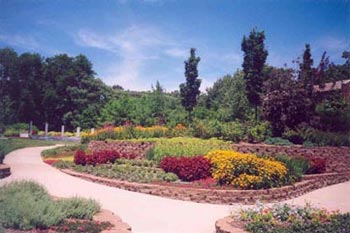
Battle Garden provides a place for community and cultural events to occur in a completely accessible site. The Martin Luther King, Jr. at Battle Garden is truly an environment designed to bring people together, whether for quiet meditation or active participation. It was officially dedicated on August 28, 1993 – the 30th anniversary of Dr. King’s “I Have a Dream” speech.
See also – MLK Capital Improvement Projects
About the Sculpture
A work of public art is a significant part of this Memorial Garden. The artist, Barbara Grygutis of Tucson, Arizona, was chosen in a national competition. Her winning design is a semi-circular earth mound built into the site. The interior of the mound is faced with five circular steps formed with granite. The surface of the stone steps are smooth so the people can sit, as in a small amphitheater. On top of the mound are eight triangular upright columns. These sculptural forms fan out to provide a radial display of the writings of Dr. King. The spiral is a global symbol for infinity. Dr. King’s teaching bear universal meaning that will live in the hearts and minds of future generations. Linda Bolton from Tucson, Arizona, assisted Ms. Grygutis in researching the King quotations.
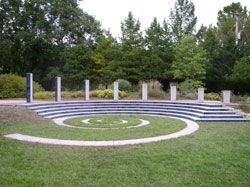
About the Artist
Barbara Grygutis is a nationally-recognized sculptor from Tucson, Arizona. She has created large-scale, site-specific sculptures for communities throughout the country including Kent, Washington; Miami, Florida and Columbus, Ohio. Her work has been exhibited at the International Quadrennial Competition in Faenza, Italy, at the Bronx Museum. It currently is included in the University of Alabama National Site Sculpture Invitational. Ms. Grygutis is the recipient of two individual artist awards from the National Endowment for the arts. In 1991, she was recognized for her contribution to urban quality by the Albuquerque Conservation Association.
My vision of the Martin Luther King, Jr. Memorial – Barbara Grygutis, Artist
“I propose to build a site-specific environmental sculpture that creates public space at the heart of Martin Luther King Jr. Memorial Garden. This space will evoke the essence of Dr. King and his teachings; non-violent protest, equality and justice for all. I visualize this space as a small amphitheater in which the late Dr. King’s will be discussed. This environment is designed to bring people together. The sculpture will create a forum in which people will congregate, a forum for meaningful dialogue, which is a primary concept of the late Dr. King’s teachings.”
Dr. King’s “I Have A Dream” Speech
“I have a dream…. it is a dream deeply rooted in the American dream. I have a dream that one day this nation will rise up and live out the true meaning of it’s creed – we hold these truths to be self-evident, that all men are created equal. I have a dream that one day on the red hills of Georgia, the sons of former slaves and the sons of former slave owners will be able to sit down together at the table of brotherhood. I have a dream that one day in the state of Mississippi, a state sweltering with the heat of injustice and oppression, will be transformed into an oasis of freedom and justice. I have a dream that my four little children will one day live in a nation where they will not be judged by the color of their skin but by the content of their character. I have a dream that one day down in Alabama, little black boys and black girls will be able to join hands with little white boys and white girls as sisters and brothers. I have a dream that one day every valley shall be exalted, every hill and mountain shall be made low, the rough places will be made plain and the crooked places will be made straight, and the glory of the Lord shall be revealed, and all flesh shall see it together. This is our hope. This is the faith that I go back to the South with. With this faith we will be able to hew out of the mountain of despair a stone of hope. With this faith we will be able to transform the jangling discords of our nation into a beautiful symphony of brotherhood. With this faith we will be able to work together, pray together, struggle together, go to jail together, stand up for freedom together, knowing that we will be free one day. This will be the day when all of God’s children will be able to sing with new meaning ‘ My country ’tis of thee, sweet land of liberty, of thee I sing. Land where my fathers died, land of the pilgrim’s pride, from every mountainside let freedom ring.’ And if America is to be a great nation this must become true. So let freedom ring from the prodigious hilltops of New Hampshire. Let freedom ring from the mighty mountains of New York. Let freedom ring from the heightening Alleghenies of Pennsylvania. Let freedom ring from the snow-capped Rockies of Colorado. Let freedom ring from curvaceous slopes of California. But not only that. Let freedom ring from Stone Mountain of Georgia. Let freedom ring from Lookout Mountain of Tennessee. Let freedom ring from every hill and molehill in Mississippi. From every mountainside let freedom ring! When we let freedom ring, when we let it ring from every village and every hamlet, from every state and every city, we will be able to speed up that day when all of God’s children, black men and white men, Jews and Gentiles, Protestants and Catholics, will be able to join hands and sing in the words of the old Negro spiritual: ‘Free at last! Free at last! Thank God Almighty, we are free at last!'”
Re-Dedication Ceremony
Re-dedication Program Brochure
The Martin Luther King, Jr. Memorial was re-dedicated August 28, 2006 on the 43rd anniversary of Dr. Martin’s “I Have a Dream” speech. About 150 people gathered for the event. Click on a thumbnail below to view a larger photo of the re-dedication event.
Martin Luther King, Jr. Memorial Restoration
Condition Problem
Not long after the construction of the Martin Luther King, Jr. Memorial, visually disfiguring deposits and runs of white calcium carbonate were noted to have developed on the granite treads and the blue tiles of the risers. Parks and Recreation personnel would routinely remove the deposits using vinegar, but this proved to be very difficult and time-consuming; and as the deposits would soon reappear, it was not possible to keep the monument looking good for more than a very short period of time. It was apparent that the monument had become a very high maintenance piece, and that its condition problems needed to be addressed in a more comprehensive manner.
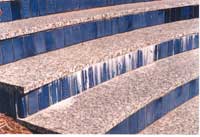
Damaged Tile
Solution Steps
The sculpture conservation firm of Russell-Marti Conservation Services, Inc. was contracted to thoroughly assess the condition of the work, and to determine the mechanism(s) of deterioration of this large and complex monument. The final determination of a treatment plan involved two phases.
Phase I comprised the study proper and reports on the findings, general recommendations, and a rough cost estimate for treatment.Phase II involved on-site materials testing. The old blue tiles were removed and a portion of the tile was replaced and observed over the course of a year.
Removal of Damaged Tile
Restoration Project
A treatment plan was devised, a new drainage system was added to redirect water from the site, and the brick and mortar from the upper walkway were removed and replaced (the mortar having contributed to the white calcium carbonate deposits). The original artist, Barbara Grygutis, fired new blue tiles, which were installed. Repairs were coordinated by Russell-Marti Conservation Services, Inc. of California, Mo., whose expertise is caring for outdoor art. The work was funded by the New Century Fund, Inc. (thanks to the generosity of local individuals and businesses), Save America’s Treasure Grant, and the City of Columbia.
Park Improvements
To compliment the restoration of the memorial, other park improvements were planned. The old sewer digesters were removed to make way for a new shelter. An interpretive plaque was placed at the shelter. A new ADA parking lot and ramp were added to serve the Columbia Audubon Society Trailside Museum. New walkways were added to connect the new parking lot, restrooms, and lower parking lot with the shelter. A retaining wall was constructed along the new sidewalk. The lower parking lot and service drive were sealed and the parking lot re-striped. Curbing was constructed for the new parking lot, lower parking lot islands, and entry drive. The old storage shed was removed. The old wooden park sign was replaced with a new stone park sign. Landscaping was added around the new constructed areas.
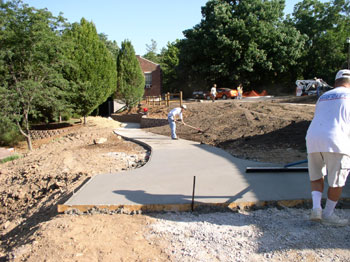
Project Funding
| MEMORIAL RESTORATION & PARK CONSTRUCTION | |
|---|---|
| Save America’s Treasures Grant | $98,768 |
| Donations* | $66,155 |
| General Fund | $10,000 |
| Office of Cultural Affairs Fund | $35,000 |
| Total | $209,923 |
| DIGESTER REMOVAL | |
| Sewer Enterprise Fund | $35,000 |
| PARKING LOT & DRIVE IMPROVEMENTS | |
| Annual Park Roads & Parking Fund | $32,034 |
*Note: An additional $20,000 in donations were collected to set up a maintenance fund for the memorial.
Save America’s Treasure Grant
The City of Columbia was awarded a Save America’s Treasures Grant from the National Park Service in the amount of $98,768 to assist in the restoration of the Martin Luther King, Jr. Memorial. The City’s match for the grant was $98,768, which consisted of a combination of force account and contracted labor to complete the improvements. The amenities funded by the grant were:
- restoration of the memorial tile
- construction of an interpretive shelter
- interpretive sign
- ADA parking
- walkways
Project Completed
The memorial testing and restoration work began in 2004, digester removal in 2005, and the majority of the park construction was accomplished in 2006. The memorial was successfully restored and the re-dedication ceremony was held on August 28, 2006 – the anniversary of Dr. King’s “I Have a Dream” speech.
Capital improvement projects and council items
| year completed | project description | council items |
|---|---|---|
| 2006 | MLK Memorial Restoration | View Council Item |

